-
![The Betrothed. From the Italian of Alessandro Manzoni. — London: Richard Bentley (successor to Henry Colburn). Cumming, Dublin; Bell & Bradfute, Edinburgh; Galignani, Paris, 1834. — Series: Standard novels, № XLIII [43]. The Betrothed. Complete in one volume.](https://varshavskycollection.com/wp-content/uploads/2021/02/LIB-1332-g-scaled-500x500.jpg) Half-title: STANDARD NOVELS. | № XLIII. | {6 lines of citation} | THE BETROTHED | COMPLETE IN ONE VOLUME. | LONDON: RICHARD BENTLEY | (SUCCESSOR TO HENRY COLBURN) : | BELL & BRADFUTE, EDINBURGH; | CUMMING, DUBLIN. | 1834 || Illustrated title page: THE BETROTHED, | FROM THE ITALIAN | OF | ALESSANDRO MANZONI. | {vignette by S. Smith after F. Pickering} | LONDON: | RICHARD BENTLEY | (SUCCESSOR TO HENRY COLBURN.) | CUMMING, DUBLIN, – BELL & BRADFUTE, EDINBURGH, | GALIGNANI, PARIS. |1834. || Title page: THE | BETROTHED. | FROM THE ITALIAN | OF | ALESSANDRO MANZONI. | LONDON: RICHARD BENTLEY, 8 NEW BURLINGTON STREET | (SUCCESSOR TO HENRY COLBURN): | BELL & BRADFUTE, EDINBURGH; | AND CUMMING, DUBLIN. | 1834 || Frontispiece: vignette by S. Smith after F. Pickering. Pagination: [i-v] 6-xii, [1] 2-452 [2 blank] + 2 plates. Collation: [A]6 B-Z8 AA-FF8 GG2 + 2 leaves of plates; Note: A1, A2, A4, GG2 – unsigned; both frontispiece and illustrated title are extraneous to collation. Binding: 2/3 black calf over marbled boards, raised bands w/gilt elements, gilt lettering in compartments and gilt title on a crimson label to spine; contemporary, but not the original publisher's binding; size: 16.5 x 10.5 cm Bookplates: Yellow sticker to front pastedown “J. K. Higgins, Northampton” (unknown); Ex libris to the front flyleaf: “Hilda Moore” (probably Hilda Mary Moore (British, 1886 – 1929) – a British stage and film actress. Series: Bentley's Standard Novels, № 43, first series. Catalogue raisonné: Michael Sadleir (1951): p. 101. Original title: ALESSANDRO MANZONI : I PROMESSI SPOSI Contributors: Manzoni, Alessandro (Italian, 1785 – 1873) Pickering, Ferdinand (British, 1810 – 1889) – artist. Smith, Samuel S. (British, 1810 – 1879) – engraver. A. Spottiswoode (London); Spottiswoode, Andrew (British, 1787 – 1866) – printer. Bentley, Richard (British, 1794 – 1871) – publisher. For the Russian edition see [LIB-1333.2017]: Алессандро Манцони. Обрученные. Повесть из истории Милана XVII века / Перевод И. И. Шитца. (Итальянская литература). — М.-Л.: Academia, 1936.
Half-title: STANDARD NOVELS. | № XLIII. | {6 lines of citation} | THE BETROTHED | COMPLETE IN ONE VOLUME. | LONDON: RICHARD BENTLEY | (SUCCESSOR TO HENRY COLBURN) : | BELL & BRADFUTE, EDINBURGH; | CUMMING, DUBLIN. | 1834 || Illustrated title page: THE BETROTHED, | FROM THE ITALIAN | OF | ALESSANDRO MANZONI. | {vignette by S. Smith after F. Pickering} | LONDON: | RICHARD BENTLEY | (SUCCESSOR TO HENRY COLBURN.) | CUMMING, DUBLIN, – BELL & BRADFUTE, EDINBURGH, | GALIGNANI, PARIS. |1834. || Title page: THE | BETROTHED. | FROM THE ITALIAN | OF | ALESSANDRO MANZONI. | LONDON: RICHARD BENTLEY, 8 NEW BURLINGTON STREET | (SUCCESSOR TO HENRY COLBURN): | BELL & BRADFUTE, EDINBURGH; | AND CUMMING, DUBLIN. | 1834 || Frontispiece: vignette by S. Smith after F. Pickering. Pagination: [i-v] 6-xii, [1] 2-452 [2 blank] + 2 plates. Collation: [A]6 B-Z8 AA-FF8 GG2 + 2 leaves of plates; Note: A1, A2, A4, GG2 – unsigned; both frontispiece and illustrated title are extraneous to collation. Binding: 2/3 black calf over marbled boards, raised bands w/gilt elements, gilt lettering in compartments and gilt title on a crimson label to spine; contemporary, but not the original publisher's binding; size: 16.5 x 10.5 cm Bookplates: Yellow sticker to front pastedown “J. K. Higgins, Northampton” (unknown); Ex libris to the front flyleaf: “Hilda Moore” (probably Hilda Mary Moore (British, 1886 – 1929) – a British stage and film actress. Series: Bentley's Standard Novels, № 43, first series. Catalogue raisonné: Michael Sadleir (1951): p. 101. Original title: ALESSANDRO MANZONI : I PROMESSI SPOSI Contributors: Manzoni, Alessandro (Italian, 1785 – 1873) Pickering, Ferdinand (British, 1810 – 1889) – artist. Smith, Samuel S. (British, 1810 – 1879) – engraver. A. Spottiswoode (London); Spottiswoode, Andrew (British, 1787 – 1866) – printer. Bentley, Richard (British, 1794 – 1871) – publisher. For the Russian edition see [LIB-1333.2017]: Алессандро Манцони. Обрученные. Повесть из истории Милана XVII века / Перевод И. И. Шитца. (Итальянская литература). — М.-Л.: Academia, 1936. -
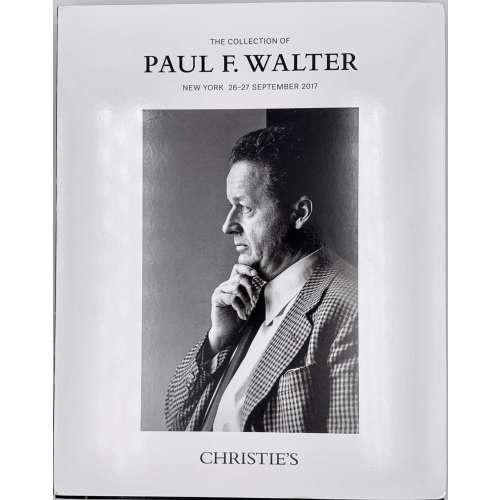 Christie's Auction Catalog; Sale WALTER-15785; New York, September 26-27, 2017; Publisher's pictorial wrappers, front cover: THE COLLECTION OF | PAUL F. WALTER | NEW YORK 26–27 SEPTEMBER 2917 | {profile chest portrait of Paul F. Walter} | CHRISTIE'S || 26.8 x 21.2 x 3 cm; 662 lots, illustrations in colour and b/w, pictorial dust jacket; pp: [2] 3-462.
Christie's Auction Catalog; Sale WALTER-15785; New York, September 26-27, 2017; Publisher's pictorial wrappers, front cover: THE COLLECTION OF | PAUL F. WALTER | NEW YORK 26–27 SEPTEMBER 2917 | {profile chest portrait of Paul F. Walter} | CHRISTIE'S || 26.8 x 21.2 x 3 cm; 662 lots, illustrations in colour and b/w, pictorial dust jacket; pp: [2] 3-462.Paul F. Walter (American, 1935 – 2017) – "Collector. Following studies in history and history of art Oberlin College, Ohio, and Columbia University, he began to collect in the1960s, starting with prints by Whistler and moving on to the Aesthetic Movement and the Arts & Crafts in Britain, as well as the arts of the Indian subcontinent and modern American painting. He was Trustee of the Museum of Modern Art from 1992-2006, and a benefactor to the Metropolitan Museum of Art, the Cooper-Hewitt Design Museum, the Morgan Library and Museum, the Brooklyn Museum, the Allen Memorial Art Museum at Oberlin College, and the Los Angeles County Museum of Art."
-
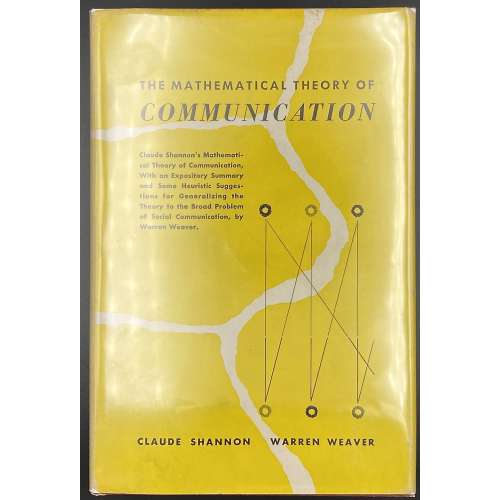 Title page: The Mathematical Theory | Of Communication | By CLAUDE E. SHANNON | and WARREN WEAVER | THE UNIVERSITY OF ILLINOIS PRESS: URBANA | 1949 || Pagination: [8] [2] 3-117 [3 blanks]. Size: 23.5 x 16 cm Binding: Publisher’s burgundy cloth, silver lettering to spine, yellow pictorial DJ with lettering: THE MATHEMATICAL THEORY OF | COMMUNICATION | {8 lines of text} {graph} | CLAUDE SHANNON WARREN WEAVER || Contributors: Shannon, Claude Elwood (American, 1916 – 2001) Weaver, Warren (American, 1894 – 1978)
Title page: The Mathematical Theory | Of Communication | By CLAUDE E. SHANNON | and WARREN WEAVER | THE UNIVERSITY OF ILLINOIS PRESS: URBANA | 1949 || Pagination: [8] [2] 3-117 [3 blanks]. Size: 23.5 x 16 cm Binding: Publisher’s burgundy cloth, silver lettering to spine, yellow pictorial DJ with lettering: THE MATHEMATICAL THEORY OF | COMMUNICATION | {8 lines of text} {graph} | CLAUDE SHANNON WARREN WEAVER || Contributors: Shannon, Claude Elwood (American, 1916 – 2001) Weaver, Warren (American, 1894 – 1978) -
 Title: GIACOMO CASANOVA | Chevalier de Seingalt | HISTORY OF MY LIFE | FIRST TRANSLATED INTO ENGLISH IN ACCORDANCE | WITH THE ORIGINAL FRENCH MANUSCRIPT | By Willard R. Trask | With an Introduction by the Translator | VOLUMES 1 AND 2 | A Helen and Kurt Wolff book • Harcourt, Brace & World, 1966 | NEW YORK || Stated 1st edition. Pagination: [2 blank] [i-iv] v-viii, [1, 2] 3-330 [8 blanks] + 32 ills. Two volumes in one.
Title: GIACOMO CASANOVA | Chevalier de Seingalt | HISTORY OF MY LIFE | FIRST TRANSLATED INTO ENGLISH IN ACCORDANCE | WITH THE ORIGINAL FRENCH MANUSCRIPT | By Willard R. Trask | With an Introduction by the Translator | VOLUMES 1 AND 2 | A Helen and Kurt Wolff book • Harcourt, Brace & World, 1966 | NEW YORK || Stated 1st edition. Pagination: [2 blank] [i-iv] v-viii, [1, 2] 3-330 [8 blanks] + 32 ills. Two volumes in one. -
 Iron tsuba of 8-lobed form pierced with six openings (sukashi) and decorated with design of bamboo and arabesque in flat brass inlay (hira-zōgan). Two of the openings serve as hitsu-ana. The design on the face represents bamboo trunks and leaves, clouds, waves, and vines; on the back - vines and leaves, that forms an arabesque (karakusa) motif. Rounded square rim. 'Silver' patina. Hitsu-ana with copper sekigane. Heianjō (most probable) or Kaga-Yoshirō school. Late Muromachi or Momoyama period; 16th century. Size: Height: 74.6 mm; Width: 69.5 mm; Thickness at seppa-dai: 4.2 mm. Weight: 113.9 g. Provenance: Gary D. Murtha. This tsuba is illustrated at: Japanese sword guards. Onin - Heianjo - Yoshiro by Gary D. Murtha [GDM Publications, 2016, p. 48]: "Iron, 80x75x3 mm tsuba with brass karakusa vines and leaves on one side with bamboo, leaves, and clouds on the reverse. This tsuba is one of those pieces that might be classified as Onin or Heianjo work, but the flush inlay tips it to the Heianjo side. Late Muromachi period." I would like to add that it easily may also be classified as Kaga-Yoshirō. Robert Haynes in Study Collection.., page 32, illustrates a look-a-like example, and writes: "This style of inlay, where the designs on the face and the back are very different, was common to the work of artists in Kyoto in the Momoyama period."
Iron tsuba of 8-lobed form pierced with six openings (sukashi) and decorated with design of bamboo and arabesque in flat brass inlay (hira-zōgan). Two of the openings serve as hitsu-ana. The design on the face represents bamboo trunks and leaves, clouds, waves, and vines; on the back - vines and leaves, that forms an arabesque (karakusa) motif. Rounded square rim. 'Silver' patina. Hitsu-ana with copper sekigane. Heianjō (most probable) or Kaga-Yoshirō school. Late Muromachi or Momoyama period; 16th century. Size: Height: 74.6 mm; Width: 69.5 mm; Thickness at seppa-dai: 4.2 mm. Weight: 113.9 g. Provenance: Gary D. Murtha. This tsuba is illustrated at: Japanese sword guards. Onin - Heianjo - Yoshiro by Gary D. Murtha [GDM Publications, 2016, p. 48]: "Iron, 80x75x3 mm tsuba with brass karakusa vines and leaves on one side with bamboo, leaves, and clouds on the reverse. This tsuba is one of those pieces that might be classified as Onin or Heianjo work, but the flush inlay tips it to the Heianjo side. Late Muromachi period." I would like to add that it easily may also be classified as Kaga-Yoshirō. Robert Haynes in Study Collection.., page 32, illustrates a look-a-like example, and writes: "This style of inlay, where the designs on the face and the back are very different, was common to the work of artists in Kyoto in the Momoyama period." -
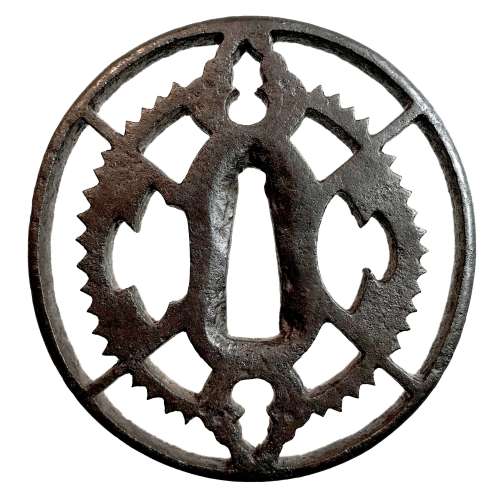
Iron tsuba of oval form pierced with design of slanting rays of light (shakoh), a Christian motif (Jesuit’s IHS symbol), and a pair of tassels in positive silhouette (ji-sukashi). Details on tassels carved in low relief. Traditional description of this kind of design is called “tokei”, or “clock gear”. Rounded rim.
Unsigned.
Edo period, 17th or 18th century. Possibly - Owari school.
Size: 76.0 x 73.0 x 6.2 mm. -
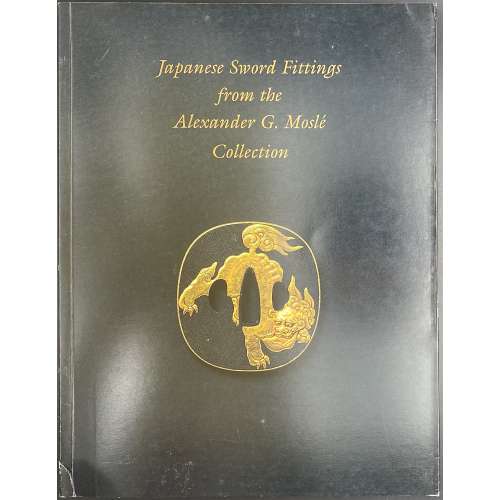 Softcover, in black pictorial flapped wrappers, 28 x 21.8 cm, 16 entries, with colour illustrations. Catalogue # 8 of the sales exhibition on March 23-30 2004 in NY; pagination: [1-3] 4-50 [2], ils., some folding. Front cover: gilt on a black background: Japanese Sword Fittings | from the | Alexander G. Moslé | Collection | {vignette ‘tsuba with shishi lion} || Contributor: Sebastian Izzard
Softcover, in black pictorial flapped wrappers, 28 x 21.8 cm, 16 entries, with colour illustrations. Catalogue # 8 of the sales exhibition on March 23-30 2004 in NY; pagination: [1-3] 4-50 [2], ils., some folding. Front cover: gilt on a black background: Japanese Sword Fittings | from the | Alexander G. Moslé | Collection | {vignette ‘tsuba with shishi lion} || Contributor: Sebastian Izzard -
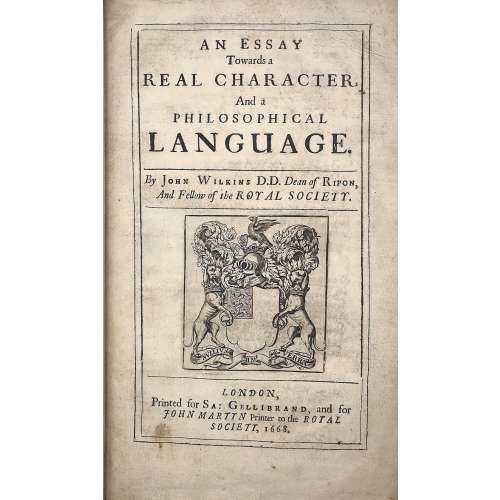 Title: AN ESSAY | Towards a | REAL CHARACTER, | And a | PHILOSOPHICAL | LANGUAGE. | By John Wilkins D.D. Dean of Ripon, | And Fellow of the ROYAL SOCIETY. |—| [armorial device] |—| LONDON, | Printed for Sa: Gellibrand, and for | JOHN MARTYN Printer to the ROYAL | SOCIETY, 1668. Pagination: [2] blank/order, [2] t.p./blank, [16], 1-454; + 79 leaves of Dictionary, unpaginated (158 pages); Illustrations: folding plates before pp. 167, 187, and two folding plates before p. 443. Collation: π2 a-d2 B-Z4 Aa-Zz4 Aaa-Lll4 Mmm3 aaa4 Aaa-Sss4 ttt3 Size: 4to, 32 x 20 x 5 cm; Binding: Full speckled calf, later polished calf spine with raised bands, double fillet ruled gilt compartments, crimson label with gilt lettering, margins sprinkled red. The work of John Wilkins is dedicated to the problem of the universal language. Wilkins was the Dean of Ripon from 1663 to 1672 and one of the founders of the Royal Society.
Title: AN ESSAY | Towards a | REAL CHARACTER, | And a | PHILOSOPHICAL | LANGUAGE. | By John Wilkins D.D. Dean of Ripon, | And Fellow of the ROYAL SOCIETY. |—| [armorial device] |—| LONDON, | Printed for Sa: Gellibrand, and for | JOHN MARTYN Printer to the ROYAL | SOCIETY, 1668. Pagination: [2] blank/order, [2] t.p./blank, [16], 1-454; + 79 leaves of Dictionary, unpaginated (158 pages); Illustrations: folding plates before pp. 167, 187, and two folding plates before p. 443. Collation: π2 a-d2 B-Z4 Aa-Zz4 Aaa-Lll4 Mmm3 aaa4 Aaa-Sss4 ttt3 Size: 4to, 32 x 20 x 5 cm; Binding: Full speckled calf, later polished calf spine with raised bands, double fillet ruled gilt compartments, crimson label with gilt lettering, margins sprinkled red. The work of John Wilkins is dedicated to the problem of the universal language. Wilkins was the Dean of Ripon from 1663 to 1672 and one of the founders of the Royal Society. -
 Six-lobed iron tsuba in a form of three ginkgo tree leaves (icho), separated with three small triangular openings (ko-sukashi). Leaves have raised rim and decorated with various family crests (mon) in low relief carving (sukidashi-bori). On obverse: bamboo stems and leaves, knotted geese, paulownia (kiri), plum blossom (ume), and ivy. On reverse: pine needles and cone, maple leaf (kaede), bamboo, stylized plum blossom, and Genji-mon. Black patina. Kozuka hitsu-ana is original, with raised rim. Copper sekigane. Kamakura-bori school. Late Muromachi period (ca. 1550). Size: Height: 81.1 mm. Width: 90.0 mm. Thickness at seppa-dai: 3.3 mm. Weight: 120.4 g.
Six-lobed iron tsuba in a form of three ginkgo tree leaves (icho), separated with three small triangular openings (ko-sukashi). Leaves have raised rim and decorated with various family crests (mon) in low relief carving (sukidashi-bori). On obverse: bamboo stems and leaves, knotted geese, paulownia (kiri), plum blossom (ume), and ivy. On reverse: pine needles and cone, maple leaf (kaede), bamboo, stylized plum blossom, and Genji-mon. Black patina. Kozuka hitsu-ana is original, with raised rim. Copper sekigane. Kamakura-bori school. Late Muromachi period (ca. 1550). Size: Height: 81.1 mm. Width: 90.0 mm. Thickness at seppa-dai: 3.3 mm. Weight: 120.4 g. -
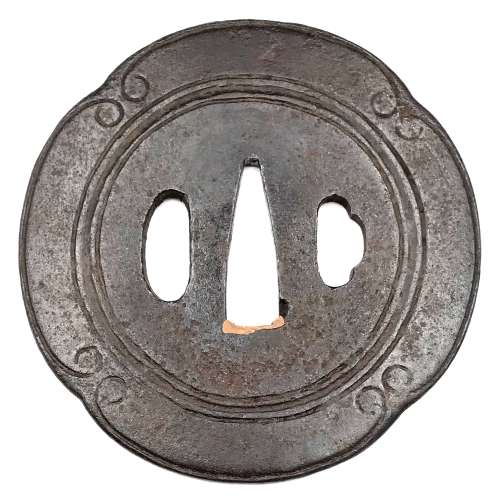 The thin, four-lobed iron plate of brownish color is carved on each side with two concentric grooves in the middle of the web, and with four thin scroll lines (handles, kan) that follow the shape of the rim. The hitsu-ana were added at a later date. Copper sekigane. Kamakura-bori school. Muromachi period, circa 1400-1550. Size: Height 80.4 mm, width 79.0 mm, thickness 3.2 mm at seppa-dai and 2.7 mm at the rim. Weight: 97.7 g. NBTHK Certificate №4004241: 'Hozon' attestation. As for the motif: the concentric circles is a widespread and generic design. It is described by John W. Dower [The Elements of Japanese Design, 1985, p. 132, #2201-30] as follows: Circle: Enclosure (wa). As a crest by itself, the cirlce carries obvious connotations of perfection, harmony, completeness, integrity, even peace. [...] Ordinary circles are labeled according to their thickness, with terminology ranging from hairline to "snake's eye". The motif that is described by both Compton Collection and R.E. Haynes as "scrolls", presented by John W. Dower as "Handle (kan): Although probably a purely ornamental and nonrepresentational design in origin, over the centuries this motif acquired the label kan, denoting its resemblance to the metal handles traditionally used on chests of drawers. [...] Very possibly the "handle" motif represents an early abstract version of the popular mokko, or melon pattern." Early Chinese Taoists claimed that special melon was associated with the Eastern Paradise of Mount Horai just as life-giving peaches were associated with the Western Paradise of the Kunlun Mountains. [...] A design motif called mokko (also translated as "melon" in accordance with the two ideographs with which it is written) may have nothing to do with the fruit. Mokko designs... are widely used as crests of both private families and Shinto shrines and are repeated as background designs that evoke a sense of classicism" [Symbols of Japan. Merrily Baird, 2001]. There is a look alike tsuba at Dr. Walter A. Compton Collection, 1992, Christie’s auction, Part II, pp. 14-15, №16:
The thin, four-lobed iron plate of brownish color is carved on each side with two concentric grooves in the middle of the web, and with four thin scroll lines (handles, kan) that follow the shape of the rim. The hitsu-ana were added at a later date. Copper sekigane. Kamakura-bori school. Muromachi period, circa 1400-1550. Size: Height 80.4 mm, width 79.0 mm, thickness 3.2 mm at seppa-dai and 2.7 mm at the rim. Weight: 97.7 g. NBTHK Certificate №4004241: 'Hozon' attestation. As for the motif: the concentric circles is a widespread and generic design. It is described by John W. Dower [The Elements of Japanese Design, 1985, p. 132, #2201-30] as follows: Circle: Enclosure (wa). As a crest by itself, the cirlce carries obvious connotations of perfection, harmony, completeness, integrity, even peace. [...] Ordinary circles are labeled according to their thickness, with terminology ranging from hairline to "snake's eye". The motif that is described by both Compton Collection and R.E. Haynes as "scrolls", presented by John W. Dower as "Handle (kan): Although probably a purely ornamental and nonrepresentational design in origin, over the centuries this motif acquired the label kan, denoting its resemblance to the metal handles traditionally used on chests of drawers. [...] Very possibly the "handle" motif represents an early abstract version of the popular mokko, or melon pattern." Early Chinese Taoists claimed that special melon was associated with the Eastern Paradise of Mount Horai just as life-giving peaches were associated with the Western Paradise of the Kunlun Mountains. [...] A design motif called mokko (also translated as "melon" in accordance with the two ideographs with which it is written) may have nothing to do with the fruit. Mokko designs... are widely used as crests of both private families and Shinto shrines and are repeated as background designs that evoke a sense of classicism" [Symbols of Japan. Merrily Baird, 2001]. There is a look alike tsuba at Dr. Walter A. Compton Collection, 1992, Christie’s auction, Part II, pp. 14-15, №16: The description goes: “A kamakurabori type tsuba, Muromachi period, circa 1400. The thin, six-lobed iron plate is carved on each side with a wide groove that follows the shape of the rim, and with six scroll lines and a single thin circular groove. […] The hitsu-ana was added at a later date, circa 1500-1550. Height 8.3 cm, width 8.6 cm, thickness 2.5 mm. The tsuba was initially intended to be mounted on a tachi of the battle type in use from Nambokucho to early Muromachi period (1333-1400)”. Sold at $935.
And another one in Robert E. Haynes Catalog #9 on page 24-25 under №23:
The description goes: “A kamakurabori type tsuba, Muromachi period, circa 1400. The thin, six-lobed iron plate is carved on each side with a wide groove that follows the shape of the rim, and with six scroll lines and a single thin circular groove. […] The hitsu-ana was added at a later date, circa 1500-1550. Height 8.3 cm, width 8.6 cm, thickness 2.5 mm. The tsuba was initially intended to be mounted on a tachi of the battle type in use from Nambokucho to early Muromachi period (1333-1400)”. Sold at $935.
And another one in Robert E. Haynes Catalog #9 on page 24-25 under №23:
 R.E. Haynes description: “Typical later Kamakura-bori style work. This type of plate and carving show the uniform work produced by several schools in the Muromachi period. Some had brass inlay and others were just carved as this one is. The hitsu are later. Ca. 1550. Ht. 8.8 cm, Th. 3.25 mm”. Sold for $175.
R.E. Haynes description: “Typical later Kamakura-bori style work. This type of plate and carving show the uniform work produced by several schools in the Muromachi period. Some had brass inlay and others were just carved as this one is. The hitsu are later. Ca. 1550. Ht. 8.8 cm, Th. 3.25 mm”. Sold for $175.
-
 Iron tsuba of round form decorated with design of pine tree mushrooms (matsutake) in openwork (sukashi). Hitsu-ana of elongated oval form. Raised rim (mimi) with iron bones (tekkotsu). Copper sekigane. Size: 84.5 mm x 85.1 mm; thickness: 3.0 mm (center), 5.6 mm (rim). Mid Muromachi period, 15th century. The shape and width of the rim, as well as the shape of the hitsu-ana, argue for earlier Muromachi. Tsuba is slightly wider than high, that might suggest middle of Muromachi age. According to Robert Haynes, circa 1450-1500.
Iron tsuba of round form decorated with design of pine tree mushrooms (matsutake) in openwork (sukashi). Hitsu-ana of elongated oval form. Raised rim (mimi) with iron bones (tekkotsu). Copper sekigane. Size: 84.5 mm x 85.1 mm; thickness: 3.0 mm (center), 5.6 mm (rim). Mid Muromachi period, 15th century. The shape and width of the rim, as well as the shape of the hitsu-ana, argue for earlier Muromachi. Tsuba is slightly wider than high, that might suggest middle of Muromachi age. According to Robert Haynes, circa 1450-1500. -
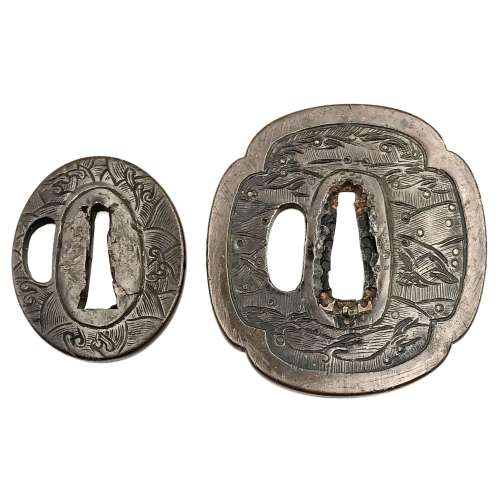 Two ymagane tsuba (daisho) with chiseled diaper pattern of waves. The larger tsuba (dai) is of mokkō form with a wide (4.6 mm) polished rim (fukurin?). Water spray is realized in copper ten-zōgan. Size: 75.0 x 71.6 x 3.2 (center), 4.0 (rim) mm. Copper sekigane. The smaller tsuba (sho) is of oval form, without a rim. No inlay. Size: 53.2 x 45.5 x 4.1 mm. Ko-kinko school. Muromachi period. In Kokusai Tosogu Kai; 5th International Convention & Exhibition, 2009 on page 51 under № 5-U8 there is a piece from George Gaucys collection, described as follows: Unsigned Tachi-Kanagushi tsuba, Yamagane base. Nami (wave) motif. Circa: Muromachi period (15th century). 6.88 x 6.81 x 0.45 (rim), 0.36 (center). The classic wave form is typically seen in Muromachi period tosogu. The patina is rich and rustic, which presents history and warmth. This tsuba may be interpreted as either tachi-kanagushi or ko-kinko work. Early tachi tsuba were symmetrical in design and also not very sophisticated, Design elements filled in up to seppadai as the waves do in this tsuba. There is a simple fikurin of the same metal and it is flat to the plate. On the ko-kinko side, the crests of the waves show more complexity than tachi works and less symmetry. A very intriguing tsuba from late Muromachi period."
Two ymagane tsuba (daisho) with chiseled diaper pattern of waves. The larger tsuba (dai) is of mokkō form with a wide (4.6 mm) polished rim (fukurin?). Water spray is realized in copper ten-zōgan. Size: 75.0 x 71.6 x 3.2 (center), 4.0 (rim) mm. Copper sekigane. The smaller tsuba (sho) is of oval form, without a rim. No inlay. Size: 53.2 x 45.5 x 4.1 mm. Ko-kinko school. Muromachi period. In Kokusai Tosogu Kai; 5th International Convention & Exhibition, 2009 on page 51 under № 5-U8 there is a piece from George Gaucys collection, described as follows: Unsigned Tachi-Kanagushi tsuba, Yamagane base. Nami (wave) motif. Circa: Muromachi period (15th century). 6.88 x 6.81 x 0.45 (rim), 0.36 (center). The classic wave form is typically seen in Muromachi period tosogu. The patina is rich and rustic, which presents history and warmth. This tsuba may be interpreted as either tachi-kanagushi or ko-kinko work. Early tachi tsuba were symmetrical in design and also not very sophisticated, Design elements filled in up to seppadai as the waves do in this tsuba. There is a simple fikurin of the same metal and it is flat to the plate. On the ko-kinko side, the crests of the waves show more complexity than tachi works and less symmetry. A very intriguing tsuba from late Muromachi period."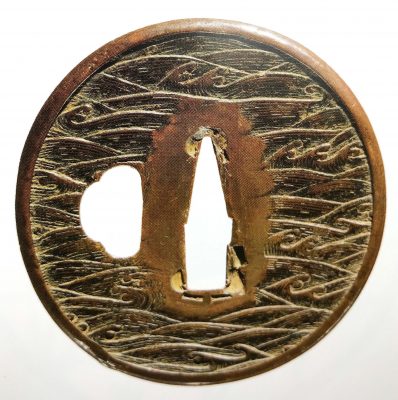
Kokusai Tosogu Kai 5th, 2009, p. 51, № 5-U8: ko-kinko or tachi-kanagushi tsuba.
-
 Iron tsuba of round form with design of military commander's fan (gunbai) in openwork (sukashi). Square rim. Hitsu-ana plugged with lead or tin. Ko-tosho school. Mid-Muromachi period (1454-1513), Entoku era (1489-92) / Meio era (1489-1501). Height: 80.3 mm, Width: 81.5 mm, Rim thickness: 3.0 mm. Centre thickness: 3.5 mm. Provenance: Sasano Masayuki Collection, №23 in Japanese Sword Guard Masterpieces from the Sasano Collection, 1994: Ko-tosho. Sukashi design: Military commander's fan (gunbai). Mid Muromachi period. Late 15th century (Entoku / Meio era). The military commander's fan (gunbai) was cherished by samurai warriors. This tsuba is relatively thick, with the large fan nicely positioned on the plate.
Iron tsuba of round form with design of military commander's fan (gunbai) in openwork (sukashi). Square rim. Hitsu-ana plugged with lead or tin. Ko-tosho school. Mid-Muromachi period (1454-1513), Entoku era (1489-92) / Meio era (1489-1501). Height: 80.3 mm, Width: 81.5 mm, Rim thickness: 3.0 mm. Centre thickness: 3.5 mm. Provenance: Sasano Masayuki Collection, №23 in Japanese Sword Guard Masterpieces from the Sasano Collection, 1994: Ko-tosho. Sukashi design: Military commander's fan (gunbai). Mid Muromachi period. Late 15th century (Entoku / Meio era). The military commander's fan (gunbai) was cherished by samurai warriors. This tsuba is relatively thick, with the large fan nicely positioned on the plate. -
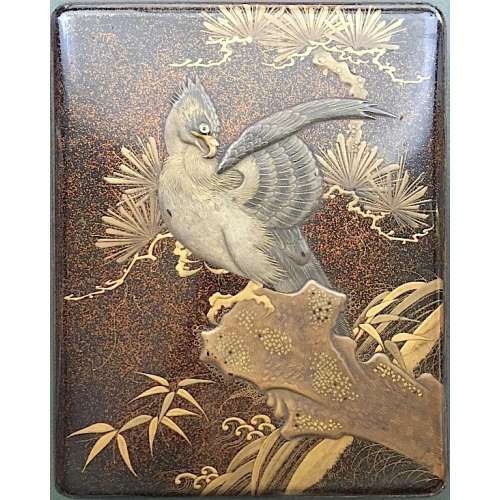 Japanese lacquer writing box (suzuribako) with an eagle sitting on a pine tree over the see waves. Rectangular box with rounded corners, slightly convex overlapping lid. Lacquer on wood with maki-e decoration in gold powder. The lid decorated inside with pine cones and needles over gold maki-e. Edo or Meiji period, 19th century.
Japanese lacquer writing box (suzuribako) with an eagle sitting on a pine tree over the see waves. Rectangular box with rounded corners, slightly convex overlapping lid. Lacquer on wood with maki-e decoration in gold powder. The lid decorated inside with pine cones and needles over gold maki-e. Edo or Meiji period, 19th century. -
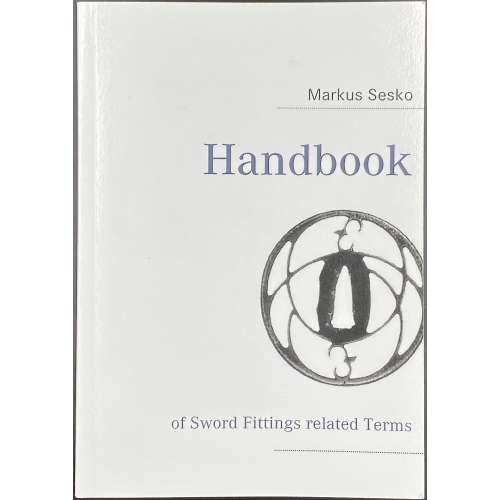 Softcover, 21 x 14.8 cm, print on demand edition, pp.: 1-88 [2], total 90 pages, pp. 1, 2, 88, and 89 blanks, p. 90 colophon. Font cover: Markus Sesko | — | Handbook | {vignette} | of Sword Fittings related Terms | — || Title-page: Handbook | of Sword Fittings | related Terms | © 2011 Markus Sesko | Herstellung und Verlag: | Books on Demand GmbH, Norderstedt | ISBN 978-308423-6422-6 || On the back cover: Blurb, publisher’s device in blue and black, barcode, and web address. Lettering to spine. Printed in the USA.
Softcover, 21 x 14.8 cm, print on demand edition, pp.: 1-88 [2], total 90 pages, pp. 1, 2, 88, and 89 blanks, p. 90 colophon. Font cover: Markus Sesko | — | Handbook | {vignette} | of Sword Fittings related Terms | — || Title-page: Handbook | of Sword Fittings | related Terms | © 2011 Markus Sesko | Herstellung und Verlag: | Books on Demand GmbH, Norderstedt | ISBN 978-308423-6422-6 || On the back cover: Blurb, publisher’s device in blue and black, barcode, and web address. Lettering to spine. Printed in the USA. -
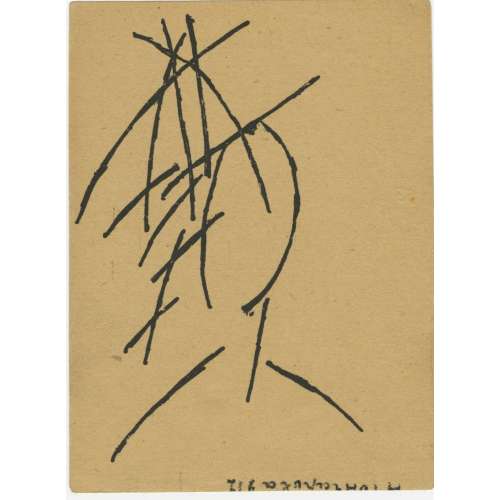 Artist: Mikhail Larionov (June 3, 1881 – May 10, 1964) ). Russian/French. Lithographic illustration "Woman in a hat" for Aleksei Kruchenykh book "Lipstick", Moscow, Kuzmin and Dolinsky Publishers, 1913, 480 copies printed. Size: 11,3 х 8,2 cm. Михаил Ларионов (3 июня 1881 – 10 мая 1964). Россия/Франция. Литографическая иллюстрация "Женщина в шляпе" к книге Алексея Крученых "Помада"; М.: Изд. Г.Л. Кузьмина и С.Д. Долинского, 1913, отпечатана в 480 экз. Формат: 11,3 х 8,2 см.
Artist: Mikhail Larionov (June 3, 1881 – May 10, 1964) ). Russian/French. Lithographic illustration "Woman in a hat" for Aleksei Kruchenykh book "Lipstick", Moscow, Kuzmin and Dolinsky Publishers, 1913, 480 copies printed. Size: 11,3 х 8,2 cm. Михаил Ларионов (3 июня 1881 – 10 мая 1964). Россия/Франция. Литографическая иллюстрация "Женщина в шляпе" к книге Алексея Крученых "Помада"; М.: Изд. Г.Л. Кузьмина и С.Д. Долинского, 1913, отпечатана в 480 экз. Формат: 11,3 х 8,2 см. -
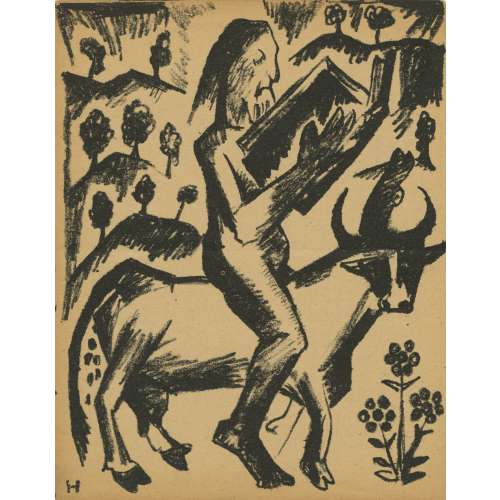 Artist: Natalia Goncharova (July 3, 1881 – October 17, 1962). Russian/French. Lithographic illustration "An elder astride a bull" for Aleksei Kruchenykh book "Two poems. The Hermit. The Hermitess", Moscow, Kuzmin and Dolinsky Publishers, 1913. This sheet is from the book "Natalia Goncharova / Mikhail Larionov" by Eli Eganbyuri (pen-name of Ilia Zdanevich), published by Z. A. Münster in 1913. Inscription on the back: hand-written copy (allegedly by the hand of Osip Brik) of Vladimir Mayakovsky verses for "Red Pepper" (Krasny peretz) magazine issue of 1924, included in the compilation "Ferocious laugh" (Grozny smekh) that was published after Mayakovsky death in 1931. Text of the manuscript on verso. Size: 18,5 х 14,3 cm. Наталия Гончарова (3 июля 1881 – 17 октября 1962). Россия/Франция. Автолитография "Старец верхом на быке" для книги А. Е. Крученых "Две поэмы. Пустынники. Пустынница"; - М.: Изд. Г.Л. Кузьмина, С.Д. Долинского, 1913. Данный лист из книги Эли Эганбюри (псевдоним Ильи Зданевича) "Наталия Гончарова / Михаил Ларионов"; - М. : Изд. Ц. Мюнстера, 1913. На обороте список стихов из подписей к "Красному перцу" 1924 г., которые вошли в сб. "Грозный смех" (вышел после смерти Маяковского в 1931). Вероятно список сделан рукой Осипа Брика. Текст манускрипта. Формат: 18,5 х 14,3 см.
Artist: Natalia Goncharova (July 3, 1881 – October 17, 1962). Russian/French. Lithographic illustration "An elder astride a bull" for Aleksei Kruchenykh book "Two poems. The Hermit. The Hermitess", Moscow, Kuzmin and Dolinsky Publishers, 1913. This sheet is from the book "Natalia Goncharova / Mikhail Larionov" by Eli Eganbyuri (pen-name of Ilia Zdanevich), published by Z. A. Münster in 1913. Inscription on the back: hand-written copy (allegedly by the hand of Osip Brik) of Vladimir Mayakovsky verses for "Red Pepper" (Krasny peretz) magazine issue of 1924, included in the compilation "Ferocious laugh" (Grozny smekh) that was published after Mayakovsky death in 1931. Text of the manuscript on verso. Size: 18,5 х 14,3 cm. Наталия Гончарова (3 июля 1881 – 17 октября 1962). Россия/Франция. Автолитография "Старец верхом на быке" для книги А. Е. Крученых "Две поэмы. Пустынники. Пустынница"; - М.: Изд. Г.Л. Кузьмина, С.Д. Долинского, 1913. Данный лист из книги Эли Эганбюри (псевдоним Ильи Зданевича) "Наталия Гончарова / Михаил Ларионов"; - М. : Изд. Ц. Мюнстера, 1913. На обороте список стихов из подписей к "Красному перцу" 1924 г., которые вошли в сб. "Грозный смех" (вышел после смерти Маяковского в 1931). Вероятно список сделан рукой Осипа Брика. Текст манускрипта. Формат: 18,5 х 14,3 см.Г. Л. Кузьмин и С. Д. Долинский знамениты, в частности, тем, что в 1912 году издали футуристский манифест "Пощечина общественному вкусу". О них можно найти дополнительную информацию в статье об Л. Л. Кузьмине. Издатель Цезарь Александрович Мюнстер был сыном знаменитого русского литографа Александра Эрнестовича Мюнстера, открывшего свое литографическое заведение в Санкт-Петербурге в 1850 году. Судьба Ц. А. Мюнстера и его издательства после революции 1917 года мне неизвестна.
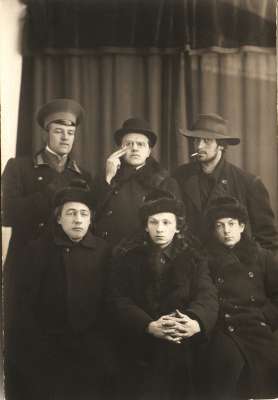
Сидят: В.В. Хлебников, Г.Л. Кузьмин, С.Д. Долинский Стоят: Н.Д. Бурлюк, Д.Д. Бурлюк, В.В. Маяковский. 1911.
-
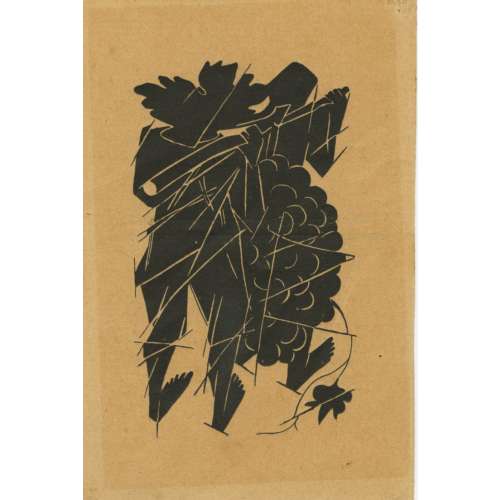 Artist: Natalia Goncharova (July 3, 1881 – October 17, 1962). Russian/French. Lithographic illustration (frontispiece) for Sergei Bobrov book of poetry "The gardeners upon the grapevines", Moscow, Lirika Publishers, 1913. Size: 18 х 11,5 cm.
Artist: Natalia Goncharova (July 3, 1881 – October 17, 1962). Russian/French. Lithographic illustration (frontispiece) for Sergei Bobrov book of poetry "The gardeners upon the grapevines", Moscow, Lirika Publishers, 1913. Size: 18 х 11,5 cm.Book was printed on May 20, 1913 for Lirika Publishers, by V. I. Voronov printshop in 500 copies, of them 50 authored and numbered. 10 lithographs by Natalia Goncharova printed at Kushneryov & Co. lithography in Moscow.
Наталия Гончарова (3 июля 1881 – 17 октября 1962). Россия/Франция. Литографическая иллюстрация (фронтиспис) к книге С. П. Боброва "Вертоградари над лозами" [Сергей Бобров. М.: /Лирика, 1913]. Формат: 18 х 11,5 см.Тираж 500 экз, из них 50 авторизованных и нумерованных. Десять цветных рисунков работы Н. Гончаровой исполнены в технике литографии на отдельных листах. Книга отпечатана 20 мая 1913 года в типографии В.И. Воронова для книгоиздательства «Лирика». В мягкой издательской обложке. На с. 162 после списка литографий: Отпечатаны литографией т-ва И.Н. Кушнерев и К° в Москве.


